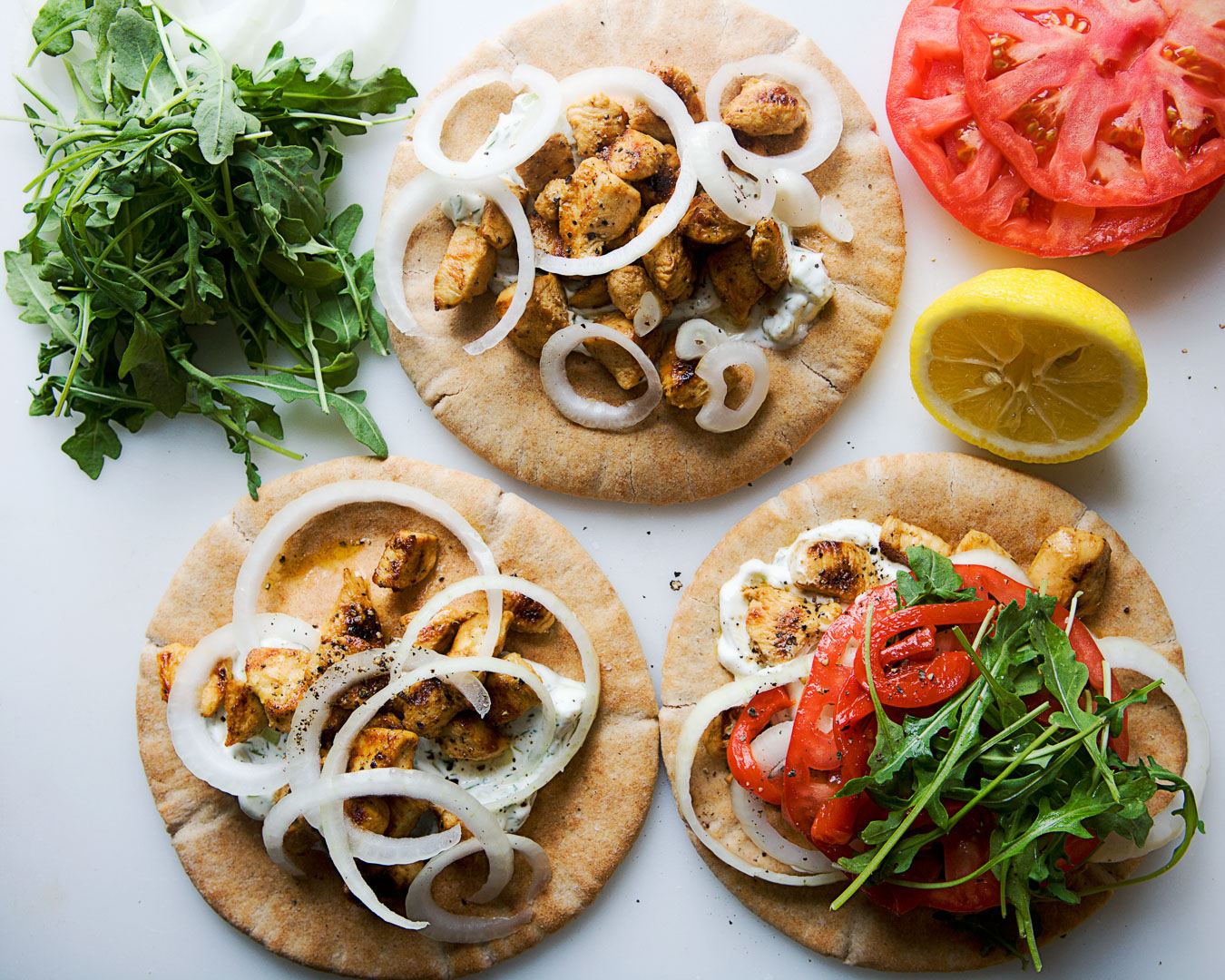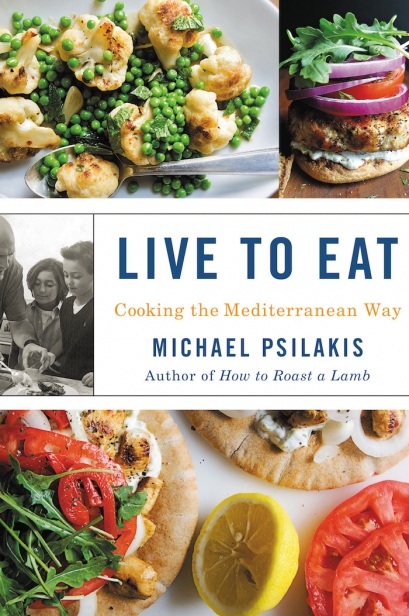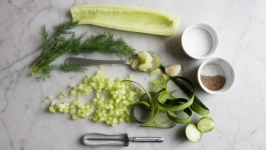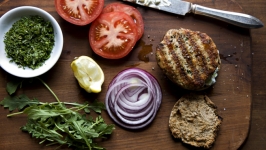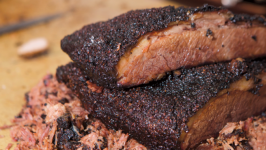Live to Eat: Cooking the Mediterranean Way
Michael Psilakis does not like leftovers. One day of reheating Sunday’s roast chicken in the oven is fine, but the last thing the Michelin-starred chef and owner of Astoria’s MP Taverna wants to do is “eat the same roast chicken, the same way, every day for a week.” Variation, both of dishes and of flavors within a single dish, is not something on which he likes to compromise.
But sometimes life gets in the way—or, as Psilakis puts it, thinking about a different meal to cook every single night after work can feel like a chore. It’s why on Sundays, he and his wife shop for filets and fish, herb bunches and a cart full of vegetables so Psilakis can not only prepare that night’s dinner, but also a handful of “condiments” his wife can throw together when making meals for their two sons.
Throughout the week, she can drop dollops of garlic confit into soups or cushion poached eggs on top of prepared roasted tomatoes; essentially, she can look at her mise en place and easily throw together exciting weeknight dishes that are both unintimidating and different each night.
“As a chef, it’s easy for me to open a fridge and see that I have lettuce, broccoli, garlic and chicken, and throw something together,” he said. “But for her and so many people, they need a little direction.”
After opening his home fridge one Sunday evening, he found himself facing neatly stacked OXO bins of roasted tomatoes suspended in their own juice, blanched and shocked vegetables and creamy garlic confit. He was excited by how cool it all looked. That’s when the revelation hit: It was time to write a cookbook about this.
Live to Eat: Cooking the Mediterranean Way, Psilakis’s newest cookbook, is his solution to three-day-old chili and fettuccine alfredo that doesn’t reheat so well. When he deconstructed his favorite dishes into their components, he was left with a handful (seven, to be exact) of different dressings and add-ins and confits—ultimately, different flavor profiles—that he argues you can rearrange like Lincoln Logs with other vegetables or proteins.
Some of the items, like Greek yogurt and garden produce, require little to no prep; you just want to keep blanched broccoli, washed blueberries, stewed strawberries and a tub of yogurt in your fridge for parfaits and effortless, vegetable-packed frittatas. Others, like roasted cherry tomatoes or sweet-and-sour peppers and onions, require some preparation. And, though Psilakis acknowledges you might not always have all seven of these on hand, you’ll hopefully “find there are some you can’t live without.”
It’s 6am on a Tuesday and Psilakis is awake. He brews coffee, then starts on breakfast for his family: toast and an egg white omelet with roasted tomatoes and feta for his wife, scrambled eggs with roasted tomatoes for his 6-year-old and cereal for his 11-year-old. Lunch prep is next: grilled chicken with Gruyère and prosciutto for his younger, and a chicken salad sandwich tzatziki for the elder. At 7:15, he catches the subway into Manhattan to make his segment on the “TODAY” show.
The morning cooking takes Psilakis around 25 minutes, partially due to his comfort in the kitchen, but also because of what he preaches in his cookbook. If on Sundays you set aside time to prepare staples like roasted tomatoes or homemade vinaigrette, you’ll be reaching for them all week to make quick meals. You’ll also find yourself getting creative with them.
A briefer on how Psilakis cooks at home, Live to Eat functions as a lifestyle guide—learn how elemental sauces and confits, and even just ingredients, function in different dishes, then do with them as you please.
It’s a new way of thinking about familiar recipes, and indicative of what Live to Eat originated as: a diet cookbook. The narrative, especially for a chef, is not unfamiliar. As someone whose life is dedicated to cooking, Psilakis has always considered food “a double-edged sword.” He even describes it as an addiction, and admits it’s gripped his life in unhealthy ways for years: His weight has fluctuated in the hundreds of pounds, he’s gone up and down a shoe size and, as with any addiction, he’s felt out of control at times. He thought he’d turn his life around with a diet cookbook, and he did.
But while his recipe tester was working on the second chapter, he had that fateful Sunday night fridge-opening moment. He called up the tester, asked for a few extra weeks to rewrite the book with a “new direction,” and started working again.
Psilakis’s approach to cooking could still be considered a diet, if you interpret “diet” as a sustainable lifestyle change that doesn’t deprive. The last kind of regimen Psilakis would want to follow is one where he’s sacrificing ice cream—his favorite splurge dessert—for savory juices.
“I don’t want to be told to juice a carrot,” he joked. “I don’t want to do that forever. I don’t even want to do that for a day.”
Instead, he looks to the Mediterranean diet with its full-fat dairy, bright acids, chunky chopped salads and lean meats; when he’s eating lemony tomato salads next to flaky grilled fish, he doesn’t feel deprived. That’s the message he wants to transmit: When you have a few core (healthy) pantry foods on hand, you can create varied, flavorful dishes every night. Once you learn how to work with a few staples, you’ll learn to innovate. It’ll be a deliberate shift, but eventually, you’ll subconsciously find yourself smearing roasted cherry pesto onto cold-cut sandwiches and dropping a spoonful on top of fried eggs. Ultimately, you’ll learn to trust your palate.
“An integrated approach [to cooking] helps you understand the depths of flavors. Even if you’re not really stopping and saying ‘Let me define the five-second palate experience,’ you still can say, ‘If I add garlic pureée to something, this is what will happen.’ Once you have that understanding, you have a world of opportunity to explore.”
When he passes through his kitchen and sees his wife and boys gathered around the cookbook and a countertop full of vegetables, he is, plainly put, “so happy.” Balancing work, raising a family and putting meals on the table is not an easy task for anyone, even a chef. Psilakis doesn’t think it has to be that way.
Live to Eat: Cooking the Mediterranean Way, Michael Psilakis. Published by Little, Brown and Company, 2017


